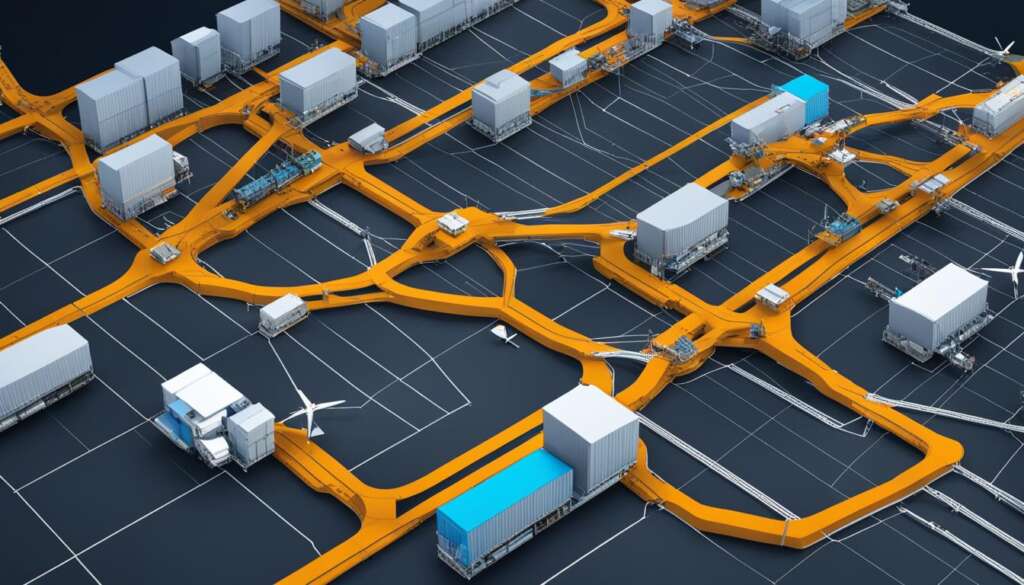Table of Contents
A supply chain is a network that encompasses all the individuals, organizations, resources, activities, and technology involved in the creation and sale of a product. It involves the entire process from sourcing raw materials, refining them into basic parts, combining those parts to create a product, order fulfillment and sales, product delivery, and customer support and return services. The distribution channel is the segment responsible for delivering the finished product to the consumer.
Within the supply chain, different entities work together, including suppliers, manufacturers, wholesalers, retailers, and various intermediaries. They collaborate to ensure the smooth flow of products and information from one stage to another.
Understanding the intricacies of the supply chain is essential for businesses to optimize their operations, improve efficiency, and meet customer demands effectively. In the following sections, we will explore the steps in the supply chain, supply chain management practices, challenges faced, best practices, and the future evolution of this vital business process.
Steps in the Supply Chain
In a supply chain, there are several fundamental steps that ensure the smooth flow of products from sourcing to customer satisfaction. These steps include:
- Sourcing: The process of identifying and procuring raw materials or components needed for the production of a product. This includes finding reliable suppliers and negotiating favorable terms.
- Refining: Once the raw materials are sourced, they undergo refining processes to transform them into basic parts that can be used in the production of the final product.
- Product Creation: The refined parts are then combined, assembled, or manufactured to create the finished product. This step involves the use of various production processes and technologies.
- Order Fulfillment and Sales: After the product is created, it needs to be made available to customers. This involves receiving and processing customer orders, managing inventory, and ensuring timely shipment.
- Product Delivery: Once the customer order is processed, the product is prepared for delivery. This step includes packaging, labeling, and arranging transportation to ensure the safe and efficient delivery of the product to the customer.
- Customer Support and Return Services: Even after the product is delivered, customer support is essential. This includes addressing customer inquiries, providing assistance, managing returns or exchanges, and ensuring customer satisfaction.
It is important to note that each of these steps has a specific time frame known as lead time. Lead time is the duration it takes to complete each process in the supply chain. Supply chain managers play a crucial role in monitoring and coordinating these steps to optimize efficiency, reduce lead time, and deliver exceptional customer experiences.
Examples of Lead Time in Different Steps of the Supply Chain
| Step in the Supply Chain | Lead Time |
|---|---|
| Sourcing | 2 weeks |
| Refining | 1 week |
| Product Creation | 4 weeks |
| Order Fulfillment and Sales | 3 days |
| Product Delivery | 1 week |
| Customer Support and Return Services | Ongoing |
Lead time in the supply chain is a crucial aspect of delivering products efficiently and meeting customer expectations. By streamlining each step and closely managing lead time, businesses can enhance their competitiveness and provide superior customer experiences.
Supply Chain Management
Supply chain management (SCM) is the backbone of any successful business. It involves the effective oversight and coordination of materials, information, and finances as they flow from the supplier to the manufacturer, wholesaler, retailer, and ultimately to the consumer.
At the heart of supply chain management is the efficient management of three key flows: the product flow, the information flow, and the finances flow. Let’s take a closer look at each of these flows:
Product Flow
The product flow refers to the physical movement of goods from one stage of the supply chain to the next. It encompasses all activities related to sourcing raw materials, manufacturing the product, storing and warehousing, transportation, and distribution to retailers or directly to customers. An efficient product flow ensures that the right products are available at the right time, in the right quantities, and in the right condition.
Information Flow
The information flow involves the exchange of data and information among different entities within the supply chain. It includes the sharing of forecasts, order information, inventory levels, production schedules, and customer demand data. A seamless information flow enables effective coordination, improves decision-making, and facilitates real-time visibility into the status of the supply chain.
Finances Flow
The finances flow focuses on the movement of money and financial transactions within the supply chain. It entails activities such as invoicing, payment processing, credit management, and financial settlement between the different entities involved in the supply chain. Sound financial management ensures the smooth flow of funds, reduces financial risks, and promotes trust and collaboration among supply chain partners.
In addition to managing these flows, supply chain management involves coordinating and integrating activities across suppliers, manufacturers, wholesalers, retailers, and other stakeholders. It aims to optimize processes, reduce costs, improve quality, enhance customer satisfaction, and drive overall business performance.
Implementing effective supply chain management practices can result in numerous benefits, including:
- Improved inventory management and reduced stockouts
- Enhanced customer service and satisfaction
- Increased efficiency and productivity
- Reduced costs and improved profitability
- Better risk management and mitigation
- Stronger relationships with suppliers and customers

As supply chains grow increasingly complex and global in nature, the role of supply chain management becomes even more crucial. It requires a deep understanding of the multi-faceted dynamics of supply chains and the ability to leverage technology, analytics, and collaboration to drive operational excellence.
“Effective supply chain management is the key to unlocking competitive advantage, driving growth, and delivering value to customers.”
Supply Chain Models
In the world of supply chain management, organizations have various models to choose from, each designed to optimize responsiveness and efficiency in different scenarios. Understanding these models can help companies make informed decisions about which approach best suits their specific needs and industry demands. Let’s explore some common supply chain models:
1. Continuous Flow Model
The continuous flow model is most effective in stable industries where demand and production remain consistent over time. This model focuses on minimizing interruptions and streamlining processes to achieve a smooth and uninterrupted flow of goods throughout the supply chain. It emphasizes reliability and can be particularly beneficial for organizations operating in industries with minimal product variability.
2. Agile Model
In contrast to the continuous flow model, the agile model is suited for industries with unpredictable demand and the need for made-to-order products. It emphasizes flexibility and quick responsiveness to market changes. Companies using the agile model often have shorter lead times, enabling them to adjust their production and distribution processes rapidly based on changing customer demands.
3. Fast Chain Model
The fast chain model is ideal for products with a short lifecycle, such as seasonal goods or trendy consumer products. Organizations adopting this model focus on reducing lead times and improving supply chain speed to ensure timely delivery of goods. It requires efficient coordination between suppliers, manufacturers, and distributors to keep up with rapidly evolving market demands.
4. Flexible Model
The flexible model is suitable for industries characterized by stability and predictable demand peaks. It allows organizations to adjust production and distribution capacity based on market fluctuations and optimize inventory levels to meet customer demands efficiently. The flexible model strikes a balance between responsiveness and cost-effectiveness.
5. Custom Configured Model
For industries where customization is a key requirement, the custom configured model offers a tailored approach. This model prioritizes meeting unique customer specifications by allowing for greater product personalization throughout the supply chain. It requires close collaboration between suppliers, manufacturers, and customers to design and produce highly customized goods.
6. Efficient Chain Model
In highly competitive markets, organizations often adopt the efficient chain model to optimize costs while ensuring timely delivery of goods. This model focuses on minimizing waste, reducing lead times, and streamlining processes to enhance overall efficiency. It requires a careful balance between cost-cutting measures and maintaining excellent customer service and satisfaction.
In summary, organizations can choose from a range of supply chain models to achieve their desired balance of responsiveness and efficiency. The continuous flow, agile, fast chain, flexible, custom configured, and efficient chain models offer distinct approaches to meet different industry demands. By selecting the most appropriate model for their specific circumstances, companies can optimize their supply chain operations and better meet customer needs.
Supply Chain Challenges
Modern supply chains face a range of challenges that can impact their efficiency and effectiveness. Supply chain managers need to be aware of these challenges and proactively address them to ensure smooth operations and meet the increasing expectations of customers and business partners. Some of the key challenges faced by supply chains today include:
- Lack of transparency: Transparency is crucial in maintaining trust and accountability within the supply chain. Without clear visibility into processes, transactions, and information, supply chains can suffer from miscommunication, delays, and even unethical practices. It is essential for supply chain managers to promote transparency and collaboration among all stakeholders.
- Waste: Inadequate production cycles can lead to waste in terms of materials, time, and resources. This waste not only adds to the overall costs but also hampers the sustainability efforts of organizations. Implementing efficient production processes and recycling initiatives can help minimize waste and improve the environmental footprint of the supply chain.
- Unsatisfied business partners and customers: Unsatisfied business partners and customers can have a detrimental impact on the reputation and success of a supply chain. It is crucial for supply chain managers to actively engage with partners and customers, address their concerns promptly, and strive for continuous improvement in products and services.
- Lost or delayed goods: Lost or delayed goods can disrupt the entire supply chain and result in dissatisfied customers. Supply chain managers must proactively manage inventory, optimize transportation and logistics, and ensure effective communication and coordination across different stages of the supply chain to reduce the risk of lost or delayed goods.
- Increasing customer expectations: With advancements in technology and the rise of e-commerce, customers have higher expectations for fast delivery, seamless tracking, and personalized experiences. Meeting these increasing customer expectations requires organizations to adopt innovative solutions, such as supply chain digitization and real-time visibility, to enhance efficiency and customer satisfaction.
- Resiliency to sudden changes: Unexpected events, such as natural disasters, economic downturns, or pandemics, can significantly disrupt supply chains. Supply chain managers need to develop robust contingency plans, diversify sourcing strategies, and build resilient networks to minimize the impact of sudden changes and ensure business continuity.
By addressing these supply chain challenges, organizations can enhance transparency, reduce waste, improve customer satisfaction, and build a resilient and adaptive supply chain to meet the demands of today’s dynamic business environment.
Supply Chain Best Practices
Adopting supply chain best practices is essential for supply chain managers to thrive in the global marketplace. By implementing these strategies, companies can achieve operational efficiency, enhance collaboration, and deliver superior customer experiences. In this section, we will explore some of the key supply chain best practices that drive success in today’s dynamic business environment.
1. Lean SCM and Logistics Techniques
One of the most effective ways to improve supply chain efficiency is through lean supply chain management (SCM) and logistics techniques. Lean SCM focuses on eliminating waste, optimizing processes, and improving overall supply chain performance. By implementing lean principles such as just-in-time (JIT) inventory management, companies can minimize excess inventory, reduce costs, and enhance flexibility.
2. Inventory Velocity
Inventory velocity refers to the speed at which inventory moves through the supply chain. By increasing inventory velocity, organizations can achieve a better balance between supply and demand, reducing excess inventory and minimizing stockouts. This can be achieved by streamlining order fulfillment processes, improving demand forecasting accuracy, and leveraging real-time data to optimize inventory management.
3. Collaboration with Supply Chain Partners
“Collaboration is key to supply chain success.”
Collaborating with suppliers, manufacturers, distributors, and other stakeholders in the supply chain is crucial for achieving seamless operations and driving overall performance. By sharing information, coordinating activities, and aligning strategies, companies can improve inventory visibility, reduce lead times, and enhance customer satisfaction. Collaborative initiatives can include joint demand forecasting, shared production planning, and shared risk management.
4. Shortening Cycles to Meet Customer Expectations
In today’s fast-paced business environment, customers have high expectations for quick and reliable order fulfillment. Shortening supply chain cycles, from order placement to delivery, is essential for meeting these expectations. By optimizing processes, leveraging automated technologies, and reducing non-value-added activities, companies can streamline their supply chains and achieve faster cycle times.
5. Utilizing Supply Chain Technology
Technology plays a pivotal role in modern supply chain management. Leveraging advanced supply chain technologies such as transportation management systems (TMS), warehouse management systems (WMS), and order management systems (OMS) enables companies to streamline operations, enhance visibility, and improve decision-making. These technologies facilitate real-time collaboration, automate manual processes, and provide valuable insights for continuous improvement.
6. Implementing Useful Metrics
Measuring supply chain performance is essential for identifying areas of improvement and driving continuous enhancement. By implementing useful metrics such as on-time delivery, order fill rate, inventory turnover, and lead time, companies can monitor their supply chain effectiveness and make data-driven decisions. These metrics provide valuable insights into operational efficiency, customer satisfaction, and overall supply chain performance.
| Supply Chain Best Practices | Benefits |
|---|---|
| Lean SCM and Logistics Techniques | Minimize waste, reduce costs, enhance flexibility |
| Inventory Velocity | Balance supply and demand, reduce excess inventory, minimize stockouts |
| Collaboration with Supply Chain Partners | Improve visibility, reduce lead times, enhance customer satisfaction |
| Shortening Cycles to Meet Customer Expectations | Improve order fulfillment speed, meet customer expectations |
| Utilizing Supply Chain Technology | Streamline operations, enhance visibility, improve decision-making |
| Implementing Useful Metrics | Monitor performance, drive continuous improvement |
By incorporating these supply chain best practices into their operations, companies can optimize their supply chains, increase efficiency, and strengthen their competitive advantage in today’s rapidly evolving business landscape.
The Evolution and Future of the Supply Chain
The evolution of the supply chain has been greatly influenced by factors such as globalization, outsourcing, and the increasing availability of information. These factors have brought significant changes and reshaped the way businesses operate within the supply chain.
Globalization has opened up new markets and opportunities for businesses around the world. It has allowed companies to expand their reach beyond local boundaries and tap into international markets. As a result, supply chains have become more complex, involving multiple stakeholders from different countries.
Outsourcing has also played a crucial role in the evolution of the supply chain. Companies now have the option to delegate certain tasks or processes to external suppliers or service providers. This practice helps businesses focus on their core competencies while allowing specialized vendors to handle specific functions within the supply chain.
“The integration of business processes across the global supply chain requires companies to optimize the entire chain rather than focusing solely on their local processes.”
The integration of business processes across the global supply chain is another significant aspect of its evolution. In the past, companies often focused on optimizing their individual processes without considering the larger supply chain network. However, with the increasing complexity and interdependence of supply chains, companies have realized the importance of aligning and coordinating their activities with other stakeholders to achieve greater efficiency and effectiveness.
The internet and technology have further revolutionized the supply chain landscape. They have facilitated direct communication and collaboration between businesses and customers, allowing for real-time feedback and customization. The use of technology has also shortened supply chains by eliminating intermediaries and streamlining processes.
As a result of these changes, customer expectations have increased significantly. The advent of internet businesses and e-commerce has provided customers with more choices and instant access to products and services. This has raised the bar for businesses, forcing them to continuously adapt and innovate to meet evolving customer demands.
The COVID-19 pandemic has further highlighted the need for agility, diversification, and visibility in supply chains. The disruption caused by the pandemic has prompted businesses to evaluate their supply chain resilience and implement measures to mitigate future risks. Digital technologies have played a crucial role in enabling businesses to adapt to the new normal by ensuring supply chain continuity and enhancing visibility.
The Future of the Supply Chain
The future of the supply chain will continue to be shaped by technological advancements and evolving customer expectations. As businesses strive to meet customer demands, they will need to prioritize factors such as sustainability, transparency, and flexibility.
Technological advancements such as artificial intelligence, blockchain, and the Internet of Things hold immense potential for transforming supply chain operations. These technologies can enhance efficiency, visibility, and traceability, allowing businesses to make data-driven decisions and optimize processes.
Furthermore, as sustainability becomes a key focus area, businesses will need to consider environmental and social impacts throughout the supply chain. This includes adopting eco-friendly practices, reducing waste, and promoting ethical sourcing.
Customer expectations will continue to shape the future of the supply chain. In an increasingly interconnected world, customers demand transparency, reliability, and personalized experiences. Businesses will need to leverage data analytics and customer insights to anticipate and meet these expectations effectively.
The evolution of the supply chain has been a dynamic process driven by various factors. From globalization and outsourcing to the integration of business processes and the influence of technology, the supply chain has undergone significant changes.
In the future, the supply chain will continue to adapt and transform to meet the ever-changing demands of customers and the global marketplace. Embracing technology, sustainability, and customer-centric strategies will be crucial for businesses to stay competitive and thrive in the evolving landscape of supply chain management.
Supply Chain Resilience and Digitalization
In today’s fast-paced and interconnected world, supply chain resilience has become crucial for businesses to thrive. Supply chains are vulnerable to various disruptions, ranging from natural disasters to geopolitical conflicts. These disruptions can have significant impacts on the flow of goods, leading to delays, shortages, and increased costs. To mitigate these risks, organizations must focus on enhancing their operational resilience and embracing digitalization.
Supply chain disruptions are unpredictable, and organizations need to be prepared to respond swiftly and effectively. By implementing robust risk management strategies and contingency plans, businesses can proactively identify potential vulnerabilities and develop mitigation measures. This includes diversifying sourcing locations, building strong relationships with suppliers, and investing in technologies that provide real-time visibility into the entire supply chain.
Inflation is another challenge that organizations must address in their supply chains. Rising costs of raw materials and transportation can significantly impact profitability. By adopting digital supply chains, businesses can optimize their procurement processes, streamline operations, and identify cost-saving opportunities. Advanced analytics and machine learning can help forecast demand accurately, optimize inventory levels, and identify potential areas for cost reduction.
Embracing digital technologies is key to building resilient and responsive supply chains. From implementing cloud-based platforms for seamless collaboration and data sharing to leveraging Internet of Things (IoT) devices for real-time tracking, digitalization offers numerous opportunities for improving efficiency and agility. Automated processes and predictive analytics can enable proactive decision-making, ensuring organizations can quickly adapt to changing market conditions and customer demands.
In conclusion, supply chain resilience and digitalization are essential for organizations to navigate supply chain disruptions, mitigate inflation risks, and enhance operational resilience. By investing in digital supply chain technologies and implementing best practices, businesses can build more agile and sustainable supply chains that can withstand the challenges of the future.
FAQ
What is a supply chain?
A supply chain is a network that encompasses all the individuals, organizations, resources, activities, and technology involved in the creation and sale of a product. It includes sourcing raw materials, refining them into basic parts, combining those parts to create a product, order fulfillment and sales, product delivery, and customer support and return services. The segment of the supply chain responsible for delivering the finished product to the consumer is known as the distribution channel.
What are the fundamental steps in a supply chain?
The fundamental steps in a supply chain are sourcing raw materials, refining those materials into basic parts, combining those parts to create a product, order fulfillment and sales, product delivery, and customer support and return services. The time it takes to complete each of these processes is known as lead time. Supply chain managers are responsible for monitoring lead time and coordinating the processes in each step to ensure customer satisfaction.
What is supply chain management (SCM)?
Supply chain management (SCM) is the oversight of materials, information, and finances as they move from the supplier to the manufacturer, wholesaler, retailer, and finally to the consumer. The three main flows in the supply chain are the product flow, the information flow, and the finances flow. SCM involves coordinating and integrating these flows within and among companies.
What are the common supply chain models?
There are several common supply chain models that organizations can adopt, each with its focus on responsiveness and efficiency. The continuous flow model works best for stable industries, while the agile model is suited for unpredictable demand and made-to-order products. The fast chain model is ideal for products with a short lifecycle, whereas the flexible model is suitable for industries with stability and predictable demand peaks. The custom configured model focuses on customization, and the efficient chain model is best for highly competitive markets.
What are the challenges faced by modern supply chains?
Modern supply chains face several challenges, including potential lack of transparency, waste due to inadequate production cycles, unsatisfied business partners and customers, lost or delayed goods, increasing customer expectations, and the need for resiliency to sudden changes in the supply chain. Supply chain managers need to address these challenges to ensure smooth operations and meet customer expectations.
What are the best practices for supply chain management?
To adapt to the global marketplace, supply chain managers should follow best practices such as using lean SCM and logistics techniques to increase flexibility and minimize waste, increasing inventory velocity to balance supply and demand, collaborating with other businesses in the supply chain, shortening cycles to meet customer expectations, utilizing supply chain technology for integration and collaboration, and implementing useful metrics to measure efficiency.
How has the supply chain evolved and what is its future?
The evolution of the supply chain has been driven by factors such as globalization, outsourcing, and the increasing availability of information. This led to the integration of business processes across the global supply chain, with companies focusing on optimizing the entire chain instead of just their local process. The internet and technology have further transformed the supply chain, allowing for direct customer contact, shortened chains, and increased customer expectations. The COVID-19 pandemic has accelerated the need for diversification, inventory management, and visibility in supply chains, with digital technologies playing a crucial role in adapting to the new normal.
What is supply chain resilience and how does digitalization contribute to it?
Supply chain resilience refers to the ability to withstand, adapt, and thrive in the face of disruptions, whether known or unknown. Supply chains face various risks, including supply chain disruptions, inflation, and the need for digitalization. Organizations need to focus on enhancing resilience, agility, and sustainability to navigate these challenges. Digitizing supply chains can improve efficiency and provide better visibility, leading to better decision-making and adaptability. By embracing digital technologies and adopting best practices, organizations can build more resilient and responsive supply chains for the future.













